William Brandon
The earliest recorded member of the Brandon family was one William Brandon (circa 1425 - 1491) of Wangford, Suffolk, and Soham, Cambridgeshire, who, during the reign of King Edward IV, became Knight Marshal of the Marshalsea prison. Brandon married Elizabeth Wingfield (d. 28 April 1497), daughter of Sir Robert Wingfield and Elizabeth Goushill, the couple had three sons and seven daughters.
Charles Brandon, Duke of Suffolk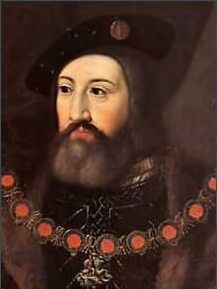
William's eldest son, Sir William Brandon (1456 - 22 August 1485) of Soham, married Elizabeth Bruyn, the daughter and co-heiress of Sir Henry Bruyn of Essex, and widow of Thomas Tyrrell of Heron. William and Elizabeth had two sons and a daughter, William Brandon who died before 1500, Charles Brandon, later 1st Duke of Suffolk (circa 1484 - 24 August 1545) and Anne Brandon, who married firstly Sir John Shilston, and secondly Sir Gawain Carew.
Sir William had taken part in the duke of Buckingham's rebellion, along with his younger brother Thomas Brandon, when the rising failed they fled to Brittany. William later served as standard-bearer to Henry Tudor at the Battle of Bosworth Field, where he was killed during the last charge of King Richard III.
Mary Tudor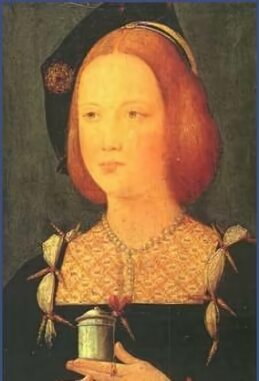
William's son, Charles Brandon, was brought up at the court of the first Tudor king, Henry VII, he was described as "a person comely of stature, high of courage and conformity of disposition to King Henry VIII". He married Margaret Neville the widow of Sir John Mortimer and daughter of John Neville, 1st Marquess of Montagu, who had been killed at the Battle of Barnet fighting for his brother Warwick the Kingmaker, against King Edward IV. The marriage was declared void in around 1507 by the Archdeaconry Court of London, and later by papal bull.
In early 1508 Brandon secretly married Anne Browne (d.1511), the niece of his first wife Margaret Neville and daughter of Sir Anthony Browne. Anne Browne presented him with two daughters, Anne Brandon (1507-1557), who was married firstly to Edward Grey, 4th Baron Grey of Powis, and later Randal Harworth and Mary Brandon (1510 - c. 1542), who married Thomas Stanley, 2nd Baron Monteagle.
A large and athletic young man, Brandon was the only member of Henry VIII's entourage capable of standing up to the king in a tournament. Charles Brandon distinguished himself at the sieges of Thérouanne and Tournai in Henry VIII's French campaign of 1513 and was created Duke of Suffolk by the king in 1514.
The Duke of Suffolk played a part in the celebrations of the marriage of Henry VIII's younger sister Mary Tudor, considered the most beautiful princess of her time, to the elderly Louis XII of France. He was dispatched to France on the death of Louis to congratulate the new French king, Francis I, and to negotiate Mary's return to England. Mary Tudor became 'la reine blanche', as it was customary to call royal widows. The custom dictated that a royal widow, 'the white queen', resided in seclusion for 40 days to make sure if she was pregnant with the heir to the throne. Suffolk and the princess seem to have been attached before her French marriage. Francis himself had been paying court to the highly attractive Princess Mary in the first week of her widowhood, Mary accused Brandon of planning to take her back to England only to have her married off again in an apolitical match against her will and issued him with an ultimatum, that he should marry her now or never marry at all. Suffolk, swayed by her tears and his ambition, risked the wrath of Henry VIII and secretly married Mary at the Cluny chapel in February 1515.
The wrath of her formidable brother had then to be faced who flew into a rage on receipt of the news, threatening to behead Brandon. In the eyes of her contemporaries, Mary had married far beneath her station. The newlyweds were eventually forgiven through the intercession of Thomas Cardinal Wolsey, although they had to pay a stiff penalty, in paying back Mary's marriage portion in annual instalments of 4000 pounds, she had also to return all the plate and jewels she had taken to France as her dowry as well as the many gifts King Louis had given her. The couple were married again, amidst feasting and celebrations in the presence of the king and queen at Greenwich Palace on 13 May. Charles and Mary had four children:-
Henry Brandon
(1) Lord Henry Brandon (11 March 1516 - 1522).
(2) Lady Frances Brandon (16 July 1517 - 20 November 1559), who married Henry Grey, Marquess of Dorset.
(3) Lady Eleanor Brandon (1519 - 27 September 1547), who married Henry Clifford, 2nd Earl of Cumberland.
(4) Henry Brandon, 1st Earl of Lincoln (c. 1523 - 1 March 1534).
Mary lived a quiet life in the country, although was known to have been present at the famous Field of the Cloth of Gold at Guines, near Calais in 1520, where her beauty was much remarked upon. Often referred to as the French Queen, rather than the Duchess of Suffolk, she was known to dislike Henry's second wife Anne Boleyn and in defiance of her brother, was to prove a firm supporter of her sister-in-law, Catherine of Aragon, in the matter of Henry VIII's annulment of his marriage to his first wife.
In April 1532 according to the Venetian ambassador, Mary publicly referred to Anne Boleyn using "opprobrious language. against Madame Anne''. Neither Mary nor her sixteen-year-old daughter Frances attended Anne's later coronation as Queen of England on June 1 1533. Charles Brandon acted as High Steward at Anne's coronation and was, against his will, sent by Henry to disband Catherine of Aragon's household.
Charles Brandon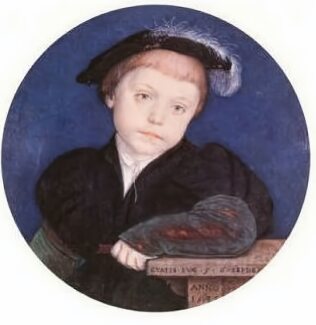
Mary Tudor died on 25 June 1533, and in September of the same year Suffolk married his thirteen-year-old ward, Catherine Willoughby (1520-1580), Baroness Willoughby de Eresby, who had been betrothed to his son Henry Brandon, Earl of Lincoln, rather than lose her large estates Brandon married her himself. Catherine, an outspoken advocate of the English Reformation was the daughter of William Willoughby, 11th Baron Willoughby de Eresby, and his second wife, Maria de Salinas, lady-in-waiting to Henry VIII's first wife, Catherine of Aragon.
By Catherine Willoughby, Suffolk had two sons, Henry (1535-1551) and Charles (c. 1537-1551), both Dukes of Suffolk, who died of sweating sickness within an hour of one another.
Charles Brandon himself died unexpectedly on August 22nd 1545 at around the age of sixty-one at Guildford, Surrey. Henry VIII sincerely mourned the loss of his brother-in-law and oldest and most loyal friend and arranged for him to be buried in St George's Chapel, Windsor, at his own expense. After his death his widow Catherine, Dowager Duchess of Suffolk remarried to the courtier Richard Bertie in around 1553, Bertie had served for several years as her Master of the Horse and Gentleman Usher. The couple fled to the continent during the reign of the Catholic Mary I and the Counter-Reformation.
Frances Brandon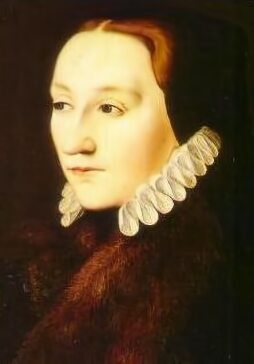
Henry VIII died in January 1547, leaving a will which stipulated that if his children Edward, Mary, and Elizabeth died without heirs, the crown would pass to his niece Frances's heirs, then to Eleanor Brandon's heirs. Frances Brandon, Suffolk's eldest daughter by Mary Tudor,who had been born at Hatfield in Hertfordshire, was married to Henry Grey, 3rd Marquess of Dorset, son of Thomas Grey, 2nd Marquess of Dorset and of Margaret Wotton, and a great-grandson of Queen Elizabeth Woodville, queen of Edward IV, by her first marriage to Sir John Grey of Groby. Dorset through right of his wife became Duke of Suffolk after the death of her two young half-brothers. The marriage produced a son who died young and three daughters :-
(1) Lady Jane Grey (12 October? 1537 - 12 February 1554).
(2) Lady Catherine Grey (25 August 1540 - 26 January 1568).
(3) Lady Mary Grey (1545 - 20 April 1578).
The Greys agreed to the request of Thomas Seymour, brother of Queen Jane Seymour, that their eldest daughter Jane should be placed in his wardship, in the hope that Thomas could engineer a match between Jane and his young nephew, Edward VI, however the scheme came to nothing. Frances Brandon was a strict mother and Jane became close to Catherine Parr, the sixth wife of Henry VIII, who had married Thomas Seymour after the death of her formidable husband. Jane was a bright child and Catherine took an interest in her education. Jane complained of her parents:-
"For when I am in presence either of father or mother; whether I speak, keep silence, sit, stand, or go, eat, drink, be merry, or sad, be sewing, playing, dancing, or doing any thing else; I must do it, as it were, in such weight, measure, and number, even so perfectly, as God made the world; or else I am so sharply taunted, so cruelly threatened, yea presently sometimes with pinches, nips, and bobs, and other ways (which I will not name for the honour I bear them) so without measure misordered, that I think myself in hell, till time come that I must go to Mr Elmer; who teacheth me so gently, so pleasantly, with such fair allurements to learning, that I think all the time nothing whiles I am with him. And when I am called from him, I fall on weeping, because whatsoever I do else but learning, is full of grief, trouble, fear, and whole misliking unto me. And thus my book hath been so much my pleasure, and bringeth daily to me more pleasure and more, that in respect of it, all other pleasures, in very deed, be but trifles and troubles unto me."
John Dudley, Duke of Northumberland and Protector during the minority of the young King Edward VI envisaged a scheme whereby Lady Jane Grey was to marry his son, Guildford Dudley, the marriage took place on 25 May 1553, at the Dudley's London residence, Durham House. He then persuaded the mortally ill Edward to disinherit his sisters, Mary and Elizabeth, declaring both to be bastards. By the terms of Henry VIII's will, the descendants of his older sister Margaret, Queen of Scots, were debarred from the succession to the throne. This left Jane, conveniently married to Northumberland's own son, as the heiress to the throne.
The Families of Grey and SeymourA few days after the death of Edward VI, Northumberland ensured that Lady Jane Grey was accordingly acknowledged as Queen, but Henry VIII's Catholic daughter, Mary Tudor, regained the throne and Jane was imprisoned in the Tower.
Henry Grey, in spite of his repeated assurances of loyalty to Quuen Mary, possessed a deep aversion to her religion. When a match was proposed with her Catholic cousin Phillip of Spain, preparations were made for a rebellion. Thomas Wyatt was to raise Kent and Suffolk, his brothers the midland counties, and Sir Peter Carew the west of England. Suffolk planned to join the rebellion. The plot, however, was betrayed to the queen by Edward Courtenay, earl of Devon. On 26 Jan. 1554 Grey to his estates in Leicestershire and Warwickshire where he was captured and taken to the Tower.
The rebellion signed the death warrant of his daughter the sixteen year old Jane Grey, who had been queen for but nine days. She was executed on Tower Green on 12th February, 1554, her young husband Guildford Dudley was beheaded earlier the same day on Tower Hill.
Her mother, Frances Brandon, first cousin to Queen Mary I, made no plea for her daughter's life and Jane's father Henry Grey already awaited execution for his part in the Wyatt rebellion, he went to the block a week after his daughter, on 19 February, 1554.
Frances and her two surviving daughters, Catherine and Mary, lived on at court, where they served Queen Mary. She later caused a minor scandal when she married her Master of the Horse, Adrian Stokes. William Camden, believed that Frances made the match "to her dishonor, but yet for her security." Marriage with a commoner distanced Frances and her surviving daughters from the crown, ensuring that Mary would not see them as a threat.
Frances had a further child by this second marriage, a daughter named Elizabeth Stokes, who died in infancy. Frances Brandon lived on until 20 November 1559 and was buried at Westminster Abbey at the expense of her cousin Queen Elizabeth I.
Frances' second daughter Lady Catherine Grey, considered the beauty of the family, later fell foul of Elizabeth I when she married Edward Seymour, 1st Earl of Hertford. Both Katherine and her husband were confined to the Tower of London.
Eleanor Brandon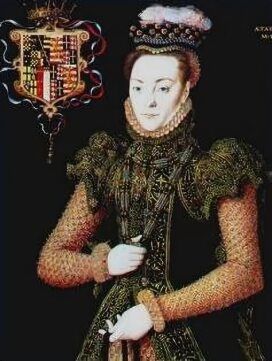
She gave birth to two sons whilst imprisoned in the Tower, Edward Seymour, Lord Beauchamp of Hache, (1561-1612), who married Honora Rogers and fathered six children, including William Seymour, 2nd Duke of Somerset, who later married another potential heiress to the throne, Arbella Stuart, in similar circumstances, and Thomas Seymour (1562/3- 8 August 1600), who married Isabel Onley. On 27 January 1568, after suffering years of imprisonment and separation from her husband and two young sons, Katherine Grey died at the age of but twenty seven at Cockfield Hall, the house of Sir Owen Hopton in Yoxford, Suffolk.
The youngest Grey daughter, Mary, was extremely small, almost a dwarf and suffered from scoliosis, or curvature of the spine. She too offended by marrying without the monarchs consent to Thomas Keyes, the Queen's serjeant porter. Thomas Keyes was from a minor gentry family of Kent, he was more than twice Mary's age, and was a widower with six or seven children. Mary herself was described by the Spanish ambassador as 'little, crook-backed and very ugly', while Keyes was an extremely tall man, reputed to have stood 6 feet 8 inches tall. Sir William Cecil wrote of the affair 'The Sergeant Porter, being the biggest gentleman of this court, has married secretly the Lady Mary Grey, the least of all the court . . . The offence is very great'.
Mary was confined to house arrest with William Hawtrey (d.1597) at Chequers in Buckinghamshire, where she remained for two years, while her husband Keyes was committed to the Fleet Prison. Mary was later placed in the custody of her step-grandmother, Catherine Willoughby and never saw her husband again, she died childless on April 1578, when plague was raging in London, and was buried with her mother in Westminster Abbey.
Eleanor Brandon the second daughter of Charles Brandon and Mary Tudor, was born sometime between 1518 and 1521. In 1536, she served as chief mourner at Catherine of Aragon's funeral. Eleanor married Henry Clifford, the eldest son and heir of Henry Clifford, 1st Earl of Cumberland and Lady Margaret Percy at Brandon house, Bridewell, in 1537, her uncle King Henry VIII attended the wedding. The Earl of Cumberland was so pleased to acquire a royal daughter-in-law, that he built an octagonal tower and a great gallery at Skipton Castle for her "more magnificent entertainment." Henry and Eleanor seem to have resided mainly at Brougham Castle until he succeeded to his father's earldom.
The couple had three children, a daughter Lady Margaret Clifford (1540 - 28 September 1596)wwho married Henry Stanley, 4th Earl of Derby. and two sons, Henry and Charles Clifford, both of whom died in infancy. She appears to have lived a quiet life, well away from court. Eleanor Clifford, Countess of Cumberland died at Brougham Castle on 27 September 1547 at the age of around twenty-seven or twenty-eight. She was buried at Holy Trinity Church in Skipton, Yorkshire.
Reginald Pole PreviousNext Catherine Grey
